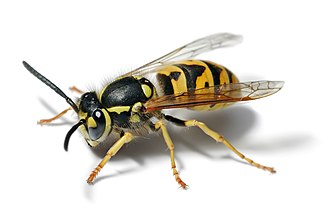Fly: Difference between revisions
CSV import |
CSV import |
||
| Line 1: | Line 1: | ||
{{Short description|Article about flies}} | |||
{{Taxobox | |||
| name = Fly | |||
| image = Six_Diptera.jpg | |||
| image_caption = Various species of flies | |||
}} | |||
'''Flies''' are insects of the order [[Diptera]], the name being derived from the Greek δι- di- "two", and πτερόν pteron "wing". Insects of this order use only a single pair of wings to fly, the hindwings having evolved into advanced mechanosensory organs known as [[halteres]], which act as high-speed sensors of rotational movement and allow them to perform advanced aerobatics. | |||
Flies are | ==Characteristics== | ||
Flies are adapted for aerial movement and typically have a pair of functional wings on the mesothorax and a pair of halteres on the metathorax. The [[halteres]] are small, knobbed structures that act as gyroscopic stabilizers, providing feedback to the fly about its position in space. This adaptation allows flies to perform complex aerial maneuvers. | |||
[[File:Anthomyiidae_(female)_(10144905255).jpg|thumb|right|A female fly from the family Anthomyiidae]] | |||
Flies have a | Flies have a mobile head, with a pair of large compound eyes, and mouthparts designed for piercing and sucking, or for lapping and sucking in the more primitive groups. Their [[life cycle]] consists of an egg, larval, pupal, and adult stage, with the larval stage being a maggot in many species. | ||
== | ==Ecology== | ||
Flies are found in almost all terrestrial habitats in the world, including deserts, forests, and urban areas. They play a crucial role in the ecosystem as pollinators, decomposers, and as a food source for other animals. Some species are important pollinators, while others are vectors of diseases. | |||
[[File:European_wasp_white_bg.jpg|thumb|left|A fly resembling a wasp]] | |||
Flies are also known for their rapid reproduction and short life cycles, which allow them to quickly exploit new environments. This adaptability makes them one of the most widespread and diverse groups of insects. | |||
==Classification== | |||
The order Diptera is divided into two suborders: [[Nematocera]] and [[Brachycera]]. Nematocera includes the more primitive flies such as mosquitoes and crane flies, while Brachycera includes the more advanced flies such as houseflies and blowflies. | |||
== | ===Nematocera=== | ||
Nematocera are characterized by their elongated bodies and long, filamentous antennae. They include families such as [[Culicidae]] (mosquitoes) and [[Tipulidae]] (crane flies). | |||
===Brachycera=== | |||
Brachycera have shorter, more robust bodies and shorter antennae. This suborder includes the [[Tabanidae]] (horse flies), [[Syrphidae]] (hoverflies), and [[Muscidae]] (houseflies). | |||
== | ==Evolution== | ||
Flies are believed to have evolved during the [[Triassic]] period, over 240 million years ago. They have since diversified into a wide range of forms and occupy a variety of ecological niches. | |||
[[File:Raphidia_icon.png|thumb|right|Illustration of a fly species]] | |||
== | ==Human Interaction== | ||
Flies have a significant impact on human activities. Some species are beneficial as pollinators or as biological control agents, while others are pests that can spread diseases such as malaria, dengue fever, and sleeping sickness. | |||
==Related pages== | |||
* [[Insect]] | * [[Insect]] | ||
* [[ | * [[Pollination]] | ||
* [[ | * [[Vector (epidemiology)]] | ||
* [[ | * [[Maggot]] | ||
[[Category:Diptera]] | |||
[[Category:Insects]] | [[Category:Insects]] | ||
Latest revision as of 11:49, 23 March 2025
Article about flies
Flies are insects of the order Diptera, the name being derived from the Greek δι- di- "two", and πτερόν pteron "wing". Insects of this order use only a single pair of wings to fly, the hindwings having evolved into advanced mechanosensory organs known as halteres, which act as high-speed sensors of rotational movement and allow them to perform advanced aerobatics.
Characteristics[edit]
Flies are adapted for aerial movement and typically have a pair of functional wings on the mesothorax and a pair of halteres on the metathorax. The halteres are small, knobbed structures that act as gyroscopic stabilizers, providing feedback to the fly about its position in space. This adaptation allows flies to perform complex aerial maneuvers.

Flies have a mobile head, with a pair of large compound eyes, and mouthparts designed for piercing and sucking, or for lapping and sucking in the more primitive groups. Their life cycle consists of an egg, larval, pupal, and adult stage, with the larval stage being a maggot in many species.
Ecology[edit]
Flies are found in almost all terrestrial habitats in the world, including deserts, forests, and urban areas. They play a crucial role in the ecosystem as pollinators, decomposers, and as a food source for other animals. Some species are important pollinators, while others are vectors of diseases.

Flies are also known for their rapid reproduction and short life cycles, which allow them to quickly exploit new environments. This adaptability makes them one of the most widespread and diverse groups of insects.
Classification[edit]
The order Diptera is divided into two suborders: Nematocera and Brachycera. Nematocera includes the more primitive flies such as mosquitoes and crane flies, while Brachycera includes the more advanced flies such as houseflies and blowflies.
Nematocera[edit]
Nematocera are characterized by their elongated bodies and long, filamentous antennae. They include families such as Culicidae (mosquitoes) and Tipulidae (crane flies).
Brachycera[edit]
Brachycera have shorter, more robust bodies and shorter antennae. This suborder includes the Tabanidae (horse flies), Syrphidae (hoverflies), and Muscidae (houseflies).
Evolution[edit]
Flies are believed to have evolved during the Triassic period, over 240 million years ago. They have since diversified into a wide range of forms and occupy a variety of ecological niches.

Human Interaction[edit]
Flies have a significant impact on human activities. Some species are beneficial as pollinators or as biological control agents, while others are pests that can spread diseases such as malaria, dengue fever, and sleeping sickness.